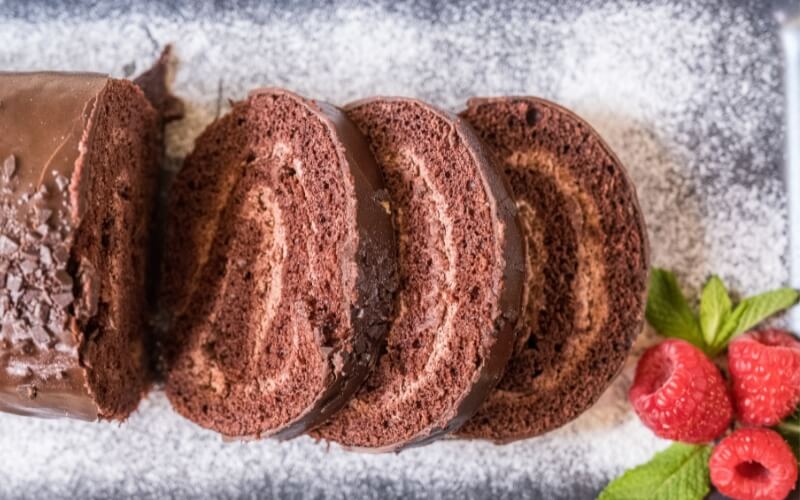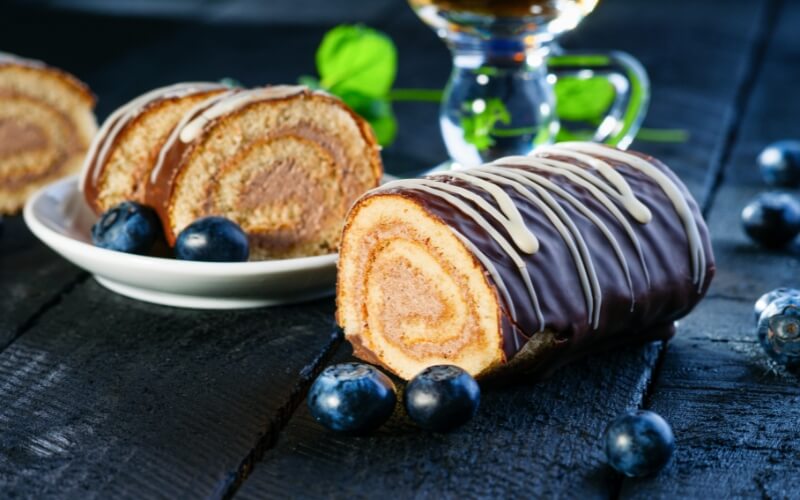Yummy Bazaar is continuing the article series about the most frequently asked questions about gourmet foods and traditional ingredients.
This time we’ll be answering the most searched questions about Swiss roll cake, one of the most popular options for those in a hurry and looking for an easy dessert to pair with coffee.
 What is a Swiss Roll Cake?
What is a Swiss Roll Cake?
Swiss Roll Cake is a cylindrical, log-shaped cake made of a medium-thick sponge base and a sweet filling spread atop.
Traditionally, it should only consist of two layers (sponge and filling). However, rolling the sponge base into a log means folding it over itself over and over. The resulting spiral cross-section creates an illusion of multiple layers.
Hand-rolled logs usually have a thicker base and are folded over themselves less, so a bakery Swiss roll cake is likely to have between 3-5 layers. In contrast, industrially manufactured logs have a thinner cake base and often sport up to 8 layers.
 Is the Swiss Roll Same as Yule Log?
Is the Swiss Roll Same as Yule Log?
Not really, though there are a lot of similarities between the two, so we understand the confusion!
Like the Swiss roll, Yule Log is a roll cake made with a sponge base and a sweet filling. That’s where the similarities end, though.
The first significant difference is the filling. Bakers have more freedom when choosing a filling for Swiss rolls. It can range from dense and sweet cream (vanilla and chocolate buttercream are the most common) to something lighter like whipped cream (sometimes with pieces of fruit) or basic like fruit jam.
In contrast, Yule Log is typically supposed to be filled with a denser cream like buttercream, icing, or ganache. A combination of yellow genoise sponge cake and chocolate buttercream is considered to be the original and most traditional. Though, denser versions, like a chocolate sponge with chocolate ganache, are not only common but arguably more popular these days than the original version. The filling layer is also much thicker in an average Yule Log than in typical Swiss rolls.
The second significant difference is the visuals. Yule Log is supposed to look a particular way: covered with a thick layer of icing and decorated to look like an actual tree log. The decorations can range from simple (like putting lines in the icing to resemble tree bark) to elaborate (with red berries, marzipan figurines, and even natural spruce branches and cones). If the cake isn’t decorated, then it isn’t a Yule Log, simple as that.
In contrast, Swiss roll is usually either left fully uncovered or iced with a thin layer of crunchy chocolate, at most. It makes a noticeable difference in flavors, with the Yule Log cream-to-cake ratio being much higher and the overall cake heavier.
 What is the Sponge Called in a Swiss Roll?
What is the Sponge Called in a Swiss Roll?
Food historians believe that the original Swiss roll cakes were made with Genoise sponge cake. Genoise is among the denser sponge cake varieties: its texture is closer to a pound cake than a classic sponge. Genoise cake is supposed to be light, but it’s on the drier side. This texture makes it hard to enjoy when eaten plainly (so it rarely ever is) but turned it into the go-to option for various classic cakes.
The modern Swiss roll cakes, however, don’t have any strict guidelines as to which type of sponge to use as the base. Anything goes from typical sponge cakes like Victoria sponge to lighter, more moist chiffon cake (Chiffon cake is, by the way, the base of choice in most Asian-style Swiss roll cakes). It’s also common to add additional flavoring ingredients to the cake (ex., cocoa).
 What Does Swiss Roll Cake Taste Like?
What Does Swiss Roll Cake Taste Like?
The taste of a Swiss roll cake depends on a wide variety of factors, from the type of sponge chosen for the base to the type of filling.
A chocolate sponge with buttercream filling is typically dense and on the sweeter side, especially if the Swiss roll is industrially manufactured. Though the level of sweetness depends on the cream flavor: vanilla cream will be lighter than, say, Dulce de Leche.
A yellow sponge with jam or jelly is typically lighter and more moderate in its sweetness level, with the sponge balancing out the preserves.
It also depends on where the cake was manufactured! For example, American pastries tend to be denser and sweeter than Italian pastries, but, on average, Italian pastries are still sweeter than Asian pastries. So a typical Japanese roll cake is likely to be lighter and significantly lower in sugar than an American-style one.
 Is Swiss Roll Cake From Switzerland?
Is Swiss Roll Cake From Switzerland?
Nope! Swiss roll cake has nothing to do with Switzerland! In fact, the Swiss themselves call similar log-shaped cakes either Roulade (in French and Swiss Standard German) and, more rarely, Biskuitroulade (in Swiss Standard German) or Rotolo (in Italian).
You can read more in-depth about where the Swiss roll cake came from (and how it looks in various parts of the world) right here in our article.
 What is Swiss Roll Called in America?
What is Swiss Roll Called in America?
It kind of depends on the type of Swiss Roll we’re talking about at any given moment:
- A yellow sponge cake filled with fruit jam or jelly is most often called a “Jelly Roll” (the United States seems to be the only country that uses this name);
- A chocolate cake with cream filling is called either a “Swiss Roll” or, sometimes, simply a “Chocolate Log.” That said, industrial manufacturers are the ones that use these terms most often, and they’re likely to use “Swiss Roll” instead of “Jelly Roll” for fruit-flavored cakes as well;
- Whenever pastry chefs at artisanal bakeries or high-end restaurants decide to put a Swiss roll-type cake on the menu, they most often eschew the “Swiss Roll” name and call the cake a Roulade. It likely serves no other purpose but to give the dessert a “luxury flair” by creating an association with fine French cuisine. It also helps avoid the association with the more commercial version of the cake.
How Do You Roll a Swiss Roll Cake? Should I Roll a Swiss Roll Hot or Cold?
The cake should be rolled while still warm (but not scorching hot, the chef should be able to freely handle the cake).
At the stage of “first rolling,” it shouldn’t yet be filled. The cake is placed on parchment paper or a tea towel and then rolled up with the paper (or towel) inside. The paper (or towel) stops the cake from sticking together while still warm.
Once the bare cake is rolled, it’s covered with a towel and cooled for 2-3 hours. The facility should be cool and (preferably) dark. Not necessarily a refrigerator, though it’s often the most accessible option, especially for home bakers.
This initial rolling phase is to avoid the crackings on the cake when the time comes to add the filling.
Once the rolled cake has completely cooled, it’s removed from the cooling facility. The cake is unrolled, has the filling spread atop it, and is then rolled again one final time.
 How is a Swiss Roll Cake Served? How Do You Eat a Swiss Roll Cake?
How is a Swiss Roll Cake Served? How Do You Eat a Swiss Roll Cake?
Swiss roll cake is commonly served cut in thin or medium slices. Notably, people tend to cut homemade and industrially manufactured Swiss rolls in thinner pieces than they’re served at bakeries. The standard recommended size of the slice is approximately 1 inch (2.54 cm) vs. 1.5 to 2 inches more common at bakeries.
The size of the slice also depends on the type of Swiss roll. For example, Japanese-style roll cakes are often cut into thicker pieces than UK or US-style Swiss rolls.
Also, this recommendation only goes for average-sized Swiss rolls. Mini snack-cake-style Swiss rolls are served (and eaten) whole.
 What Do You Pair with a Swiss Roll Cake?
What Do You Pair with a Swiss Roll Cake?
Swiss roll cakes are a typical example of a quick dessert. They’re usually served as they are, at room temperature or cold, accompanied by only someone’s beverage of choice.
Coffee and tea are the most common choices (no surprise here), but pairing it with hot chocolate or cocoa in the colder months or with iced soda in hotter ones isn’t unusual. The primary appeal of a Swiss cake is, after all, the easiness: you can grab it and serve it at a moment’s notice.
On the other hand, if you’re interested in elevating the flavors, then you can serve the Swiss roll with additional toppings that accentuate the flavors. A classic yellow sponge-fruit jam roll will pair great with a scoop of vanilla ice cream and pieces of fresh fruit (preferably the same one as the jam). A denser, sweeter chocolate sponge with buttercream filling will taste even better with some whipped cream and tart red berries.
It’s best to serve the cake with unsweetened black coffee or tea. Swiss rolls, particularly the ones from commercial manufacturers, tend to veer on the sweeter side.
 Can You Heat Up a Swiss Roll Cake?
Can You Heat Up a Swiss Roll Cake?
Heating Swiss roll cake isn’t advisable. Commercially packed Swiss rolls are designed to be served straight out of the package, and the artisanal ones at bakeries are typically served cold.
You can try carefully heating a Swiss roll in a microwave at about 15-second intervals. You’ll need to keep an eagle eye on it, though, especially if it has icing on top (it’ll melt very quickly). The cake will become dry and unpleasant if you overdo even a little bit.
Better serve it as the creator intended.
 How Long Does a Swiss Roll Cake Last?
How Long Does a Swiss Roll Cake Last?
Like most other pastries, the shelf life of commercially packaged Swiss roll cakes considerably differs from that of freshly baked ones.
A fresh Swiss roll cake with buttercream filling from a bakery is best consumed within 24 hours but can last up to 72 hours if it’s properly stored. A classic Jelly roll that’s just sponge cake and jelly (without cream) can last for a couple of days more, though it, as well, is best when consumed within 24 hours.
Meanwhile, the shelf life of commercially packaged Swiss rolls is dramatically different depending on the manufacturing company. There are brands out there with Swiss roll shelf life as short as just three weeks, and there are brands that claim their Swiss rolls are suitable for consumption for up to 8 months, as long as the vacuum packaging isn’t damaged.
It’s hard to discern the average shelf life of an industrially manufactured Swiss cake considering the dispersion, but it seems that the majority stick to the expiration date of around three months.
That said, this is a highly variable pastry, depending on the brand, so you should always check the label for the best-by or expiration date.
Once the package has been opened, the shelf life of the Swiss roll cake will dramatically decrease. Treat it like you would a freshly baked one from that moment and consume it within 3-4 days.
 Can You Leave a Swiss Roll Cake Out Overnight?
Can You Leave a Swiss Roll Cake Out Overnight?
Despite being quite delicate overall, a Swiss roll cake can actually survive at room temperature overnight without any damage! We don’t recommend doing it during summer, as it is still vulnerable to high temperatures and humidity (especially the cream-filled one). Otherwise, yes, you can leave out the cake overnight.
However, if you intend to divide the cake into several portions and have it last 3-5 days, it’s best if you transfer it to an airtight container and keep it in the fridge.
 Can You Freeze a Swiss Roll Cake?
Can You Freeze a Swiss Roll Cake?
Yes, you can! Freezing prolongs the Swiss roll’s life by about three months. It’s best to pre-slice the roll and wrap each slice individually in parchment paper before placing it in an airtight container and freezing.
Again, don’t use either a microwave or oven to defrost. There’s a high chance that it’ll dry out your cake. Instead, place the slices in the refrigerator overnight and then keep them at room temperature for about an hour before serving. Swiss roll defrosted this way should still maintain optimal moist texture.
 Check Out Yummy Bazaar’s Online Italian Grocery Store for More Premium Italian Sweets!
Check Out Yummy Bazaar’s Online Italian Grocery Store for More Premium Italian Sweets!
Yummy Bazaar hosts one of the largest assortments of authentic gourmet-grade Italian sweets in our online Italian grocery store. Explore the snack, pastry, and sweets collections to discover a vast array of premium options. Like chocolates from some of the biggest brands in the world, like Perugina and Venci, a wide variety of snack cakes and rolls, classic Italian torrone nougat candies with flavors ranging from classic almond and chocolate to various unique options like strawberries, sour cherries, rum-raisin, tiramisu, etc. and, of course, an extensive collection of authentic Italian cookies from brands like Mulino Bianco, Matilde Vicenzi, Borgo de Medici, and more!


